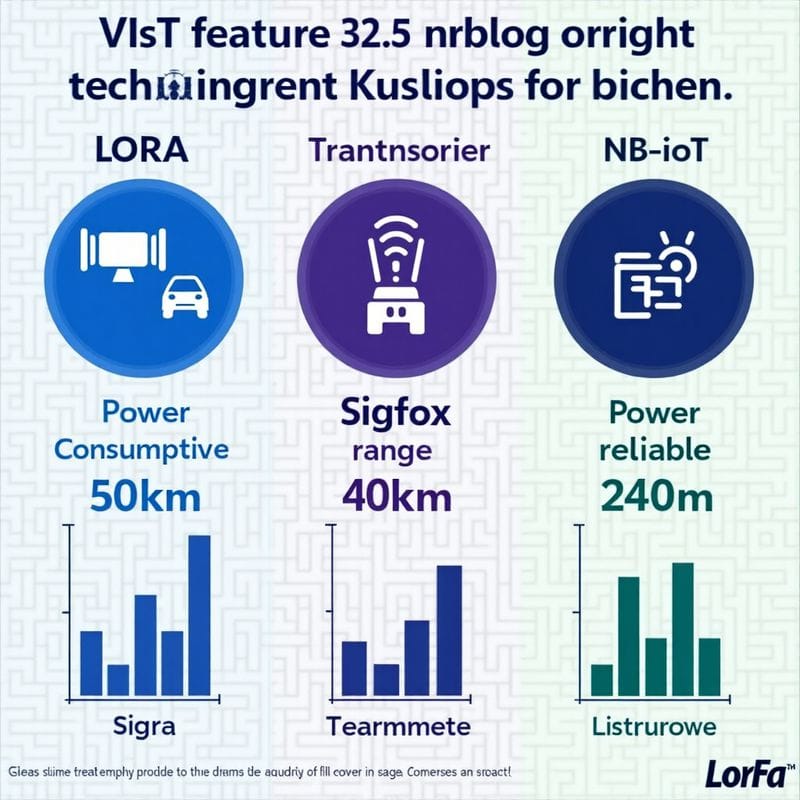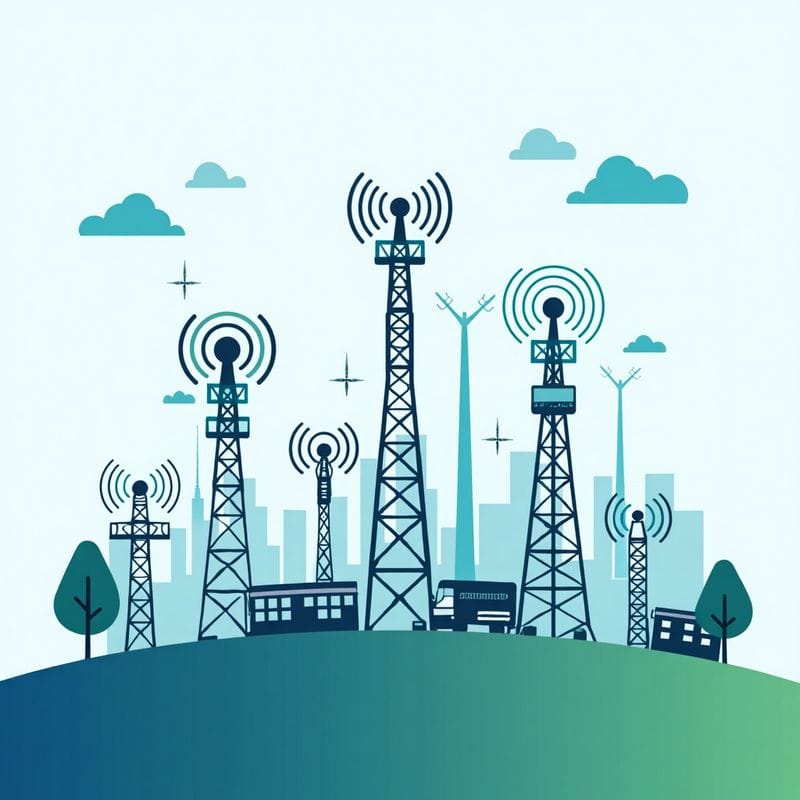Advantages and Features of LoRa, Sigfox, and NB-IoT Wireless Communication Technologies for IoT
Introduction to IoT Wireless Communication Technologies
Wireless communication technology forms the foundation of the Internet of Things (IoT). As smart cities become a hot development trend, various technologies are emerging to compete for the IoT market. Among LPWAN (Low Power Wide Area Network) technologies, the most popular ones are undoubtedly LoRa, Sigfox, and NB-IoT. In the IoT landscape, what unique advantages do these three technologies offer? Which one will be the best partner for your professional field?

For professionals in related industries, terms like Internet of Things, Big Data, and AI artificial intelligence are undoubtedly familiar. Within the IoT technical architecture, “sensing” is the most fundamental core source. Whether in agriculture, industry, construction, transportation, or healthcare, to enable AI analysis of sensed data and subsequently develop relevant applications, appropriate transmission technologies and networks must first be deployed to collect and report massive environmental data.
Early Wireless Communication Technologies in IoT
In wireless communication, several earlier applications like Wi-Fi, Bluetooth, ZigBee, and Z-Wave have already established development foundations in different fields:
- Wi-Fi is suitable for large data volume transmission, such as audio/video or AR/VR applications, and serves as the basis for general wireless networks. Its drawback is high power consumption.
- Bluetooth is commonly used for personal wearable devices, with mature applications in the audio field.
- ZigBee and Z-Wave have achieved fruitful results in industrial and building automatic control applications.
LPWAN: Solving IoT Transmission Challenges with Long Distance and Low Power
When discussing wireless networks, apart from Wi-Fi, mobile communication networks used by smartphones likely come to mind. Today’s communication technology is approaching 5G, emphasizing greater bandwidth, higher rates, and lower latency, but also consuming more power. Since it’s designed for human-to-human communication, data transmission is more intensive with larger exchange volumes.
For M2M (Machine-to-Machine) communications, where device deployment usually covers wider areas and wireless devices must avoid frequent battery replacements, LPWAN technology has emerged. Its characteristics of small data volume, long-distance transmission, and power efficiency shine brightly in IoT applications.
Earlier wireless transmission technologies like Wi-Fi, ZigBee, and Z-Wave have a transmission distance of at most 100 meters. For smart home applications, signal-boosting antennas or relay stations must be added. To meet smart city applications such as environmental monitoring or asset tracking, LPWAN technology with a transmission distance of up to 20 kilometers can significantly reduce deployment costs, with just a few stations covering large areas. Using batteries as power sources eliminates wiring issues, making sensor installation simpler.
Currently, the most attention-grabbing LPWAN technologies are LoRa, Sigfox, and NB-IoT. Each has its own advantages, allowing users to choose the most suitable communication technology based on different domains and usage requirements.
Comparing LoRa and Sigfox: Low Energy Consumption with High Range Transmission
As characteristic of LPWAN technology, both LoRa and Sigfox feature long-distance, low-power properties that extend battery life and enable wide-range message transmission. Both use unlicensed Sub-1GHz ISM bands, requiring no additional authorization fees. With breakthroughs in electronic chip manufacturing technology, hardware manufacturing costs for both technologies continue to decrease.
LoRaWAN is a network standard jointly promoted by industry alliances, offering open technology. Once key content is obtained, individual applications can be developed. Unlike LoRa’s openness, Sigfox is a technology developed by the French company of the same name, which controls core network operations and deployment, intending to act as an independent operator establishing network bases globally. Currently, it can be used in 36 countries and regions with connectable networks and devices.
In terms of type, LoRa is comparable to a small private network with a maximum transmission distance of 20 kilometers. With technical knowledge, users can set up their own base stations, offering greater freedom.
Sigfox, on the other hand, aims to operate globally, continuously expanding its network base blueprint, providing users with existing network deployment and cloud services. It requires additional monthly fees, making it relatively more expensive than LoRa, but it offers complete platform solutions without requiring additional network building. Sigfox’s transmission distance can reach 50 kilometers, the widest range among the three technologies. However, to achieve low power consumption, both LoRa and Sigfox limit daily transmission times, making them suitable for fields without real-time communication requirements, such as sensors reporting fixed daily data measuring temperature, humidity, PM2.5, and other specific environmental data.
NB-IoT: Strongly Promoted by Telecom Operators
Another hotly discussed technology in the IoT industry chain is NB-IoT. Its biggest difference from the previously mentioned technologies is that it’s established by the 3GPP organization, using licensed GSM and LTE bands. This means NB-IoT must be authorized through telecommunications industries purchasing frequency bands, and users can only access NB-IoT-related services through telecom operators or third-party agents.
NB-IoT’s advantage is that it’s a technology launched by existing telecom operators, requiring no new network deployment. Existing 4G telecom base stations and related equipment can be used with just software updates. Additionally, using telecom-grade networks provides high assurance of communication quality and message security.

“Placing the Right Technology in the Right Position” — Applications of Wireless Communication Technologies
The three popular LPWAN technologies mentioned above each have different characteristics. Many in the industry predict that one technology will eventually dominate. However, as LoRa co-founder Olivier Hersent once said, a cooperative coexistence relationship is more likely to lead future technology toward new developments. In fact, with hundreds of IoT application fields, these three technologies’ characteristics correspond to different domains’ special needs.
For example, NB-IoT, with its user-licensed frequency bands and LTE technology, doesn’t limit message transmission times and can carry more data, making it suitable for the smart industrial field that values network transmission stability and real-time capabilities, or IoT devices requiring high data transmission like voice and image files. Comparatively, NB-IoT’s power consumption is higher than the other two technologies, resulting in greater battery life depletion. Meanwhile, collaboration with telecom operators makes promotion to users faster and more convenient, though it’s also limited by hardware (chip) costs and monthly rental costs.
Compared to NB-IoT, LoRa and Sigfox, with their lower hardware costs and lower power consumption, are more suitable for small data volume, large-range transmission applications. LoRa technology has reached a mature development scale and has cooperated with Asia Pacific Telecom and Foxconn in Taiwan. Although its transmission distance isn’t as far as Sigfox’s, it has higher transmission bandwidth, lower construction costs, and lower technical difficulty, making it suitable for building closed networks in high-tech factory areas to transmit various types of sensing data.
From a global deployment perspective, Sigfox is a technology with great development potential. Since Sigfox provides global network services, it’s more convenient for multinational companies, especially with its all-in-one network solution that offers complete and stable cloud services for high-yield companies, eliminating many development and collaboration troubles. Sigfox has the longest transmission distance but the fewest daily transmission times, making it suitable for scenarios that respond to data changes or send data at fixed intervals, such as pipeline monitoring, smart meters, regional climate monitoring and alerts, etc.
Future Vision of IoT: Information Security and Technology Verification Are Essential
Emerging technologies bring more convenient and better future visions while also raising concerns about security. When various information flows on networks, network security issues can lead to personal privacy leaks or even affect personal safety. In Europe, where privacy rights are highly valued, the General Data Protection Regulation (GDPR) has been passed, strictly regulating network companies’ restrictions and management of personal data collection.
A senior manager also reminds us that all wireless communication technologies must pass national regulations and alliance certification standards. First, they must comply with each country’s regulations on wireless communication frequencies and power control, ensuring qualified communication standards that won’t affect other electronic instruments or human health due to enhanced communication. They must also meet standards of various technology alliances, including electromagnetic wave types, communication protocols, and interoperability tests, ensuring products using the same type of communication technology can communicate with each other.

All things considered
Regardless of the field—transportation, industry, agriculture, construction, healthcare, finance, etc.—IoT will focus on new applications under data. Device networking is just the foundation; only by making good use of software services and grasping application opportunities can the true intelligence of IoT be realized. AIWEDO Co., Ltd. is a high-tech enterprise focused on IoT communication, with hundreds of independently developed products recognized by customers. The company possesses strong R&D technical strength and comprehensive after-sales systems, providing customers with complete solutions and technical support, shortening R&D cycles, reducing R&D costs, and offering a powerful platform for new product development ideas.